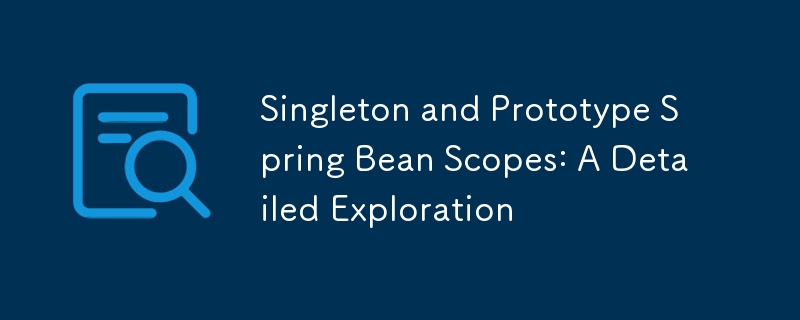
当我第一次开始使用 Spring 时,最让我感兴趣的概念之一是 bean 作用域的想法。 Spring 提供了各种 bean 作用域,用于确定在 Spring 容器中创建的 bean 的生命周期。最常用的两个范围是 Singleton 和 Prototype。理解这些范围对于设计高效且有效的 Spring 应用程序至关重要,所以让我向您介绍我对它们的了解。
在 Spring 中,bean 是由 Spring IoC(控制反转)容器实例化、组装和管理的对象。 Bean 作用域是指 bean 的生命周期 — 如何、何时创建 bean 实例,以及它们持续多长时间。
Spring 提供了几种 bean 作用域,但我将重点关注的两个是:
每个范围都有其特定的用例,选择正确的范围可以显着影响应用程序的行为和性能。
Singleton 作用域是 Spring 中的默认作用域,也是我最常使用的作用域。当使用 Singleton 范围定义一个 bean 时,这意味着 Spring 容器将仅创建该 bean 的一个实例,并且该单个实例将在整个应用程序上下文中共享。
当我将一个 bean 声明为 Singleton 时,Spring 在第一次请求时(在应用程序上下文启动期间或首次引用它时)创建该 bean 实例。之后,对该 bean 的每个后续请求都将返回相同的实例。
这是一个简单的例子:
在此示例中,myService() 是一个 Singleton bean。每次我从 Spring 上下文请求 MyService bean 时,我都会得到相同的实例。
我发现 Singleton 作用域非常适合无状态 Bean——那些不保存任何客户端特定信息的 Bean。示例包括:
Singleton beans 的主要好处是内存效率。通过重用单个实例,应用程序消耗更少的内存,并且创建和销毁对象的开销最小化。然而,对维护状态的 Singleton beans 保持谨慎是很重要的。如果 Singleton bean 无意中保存了状态(例如实例变量),则该状态可以在多个客户端之间共享,从而导致潜在的数据不一致。
与 Singleton 相比,Prototype 范围在每次从 Spring 容器请求 bean 时都会创建一个新的 bean 实例。当我了解到这一点时,很明显 Prototype beans 对于每次使用都需要一个新实例的场景非常有用。
当使用 Prototype 作用域定义 bean 时,每次请求该 bean 时 Spring 都会返回一个新实例。以下是我定义 Prototype bean 的方式:
在此示例中,每次我从 Spring 上下文请求 MyService bean 时,Spring 都会创建 MyService 的一个新实例。
原型 Bean 在处理有状态 Bean 时特别有用 - 那些维护某种特定于客户端的状态或每次使用都需要唯一配置的 Bean。一些典型的用例包括:
The primary advantage of using Prototype beans is the flexibility it offers in creating new instances. This is particularly useful when dealing with stateful objects. However, there’s a trade-off in terms of performance and resource usage. Since a new instance is created every time, it can lead to higher memory consumption and more frequent garbage collection. Moreover, unlike Singleton beans, Spring does not manage the lifecycle of Prototype beans beyond creation, so I have to handle the destruction and cleanup of these beans manually.
One of the key decisions I face when designing a Spring application is choosing between Singleton and Prototype scope. Here’s a summary of the factors I consider:
Let me provide a practical scenario that might help clarify when to use each scope. Suppose I’m building an online shopping application.
One thing I’ve learned the hard way is that mixing Singleton and Prototype beans can lead to unexpected issues. For example, injecting a Prototype-scoped bean into a Singleton bean can result in the Singleton bean always using the same instance of the Prototype bean. To avoid this, I usually inject a Provider or use the @Lookup annotation to ensure a new instance of the Prototype bean is created every time it is needed.
@Service public class SingletonService { @Autowired private Provider myPrototypeServiceProvider; public void usePrototypeService() { MyPrototypeService prototypeService = myPrototypeServiceProvider.get(); prototypeService.execute(); } }
In this example, myPrototypeServiceProvider.get() ensures that a new instance of MyPrototypeService is created every time it is called within the Singleton bean.
Understanding the nuances of Singleton and Prototype bean scopes in Spring has been critical in my journey as a developer. Both scopes offer distinct advantages depending on the use case, and choosing the right one can significantly impact the performance and design of an application.
In my experience, Singleton is the go-to scope for most beans due to its efficiency and simplicity, while Prototype is reserved for those special cases where I need a fresh instance every time. By carefully considering the statefulness of my beans and how they are used within the application, I can make informed decisions that lead to better, more maintainable Spring applications.
以上是Singleton 和原型 Spring Bean 范围:详细探索的详细内容。更多信息请关注PHP中文网其他相关文章!




